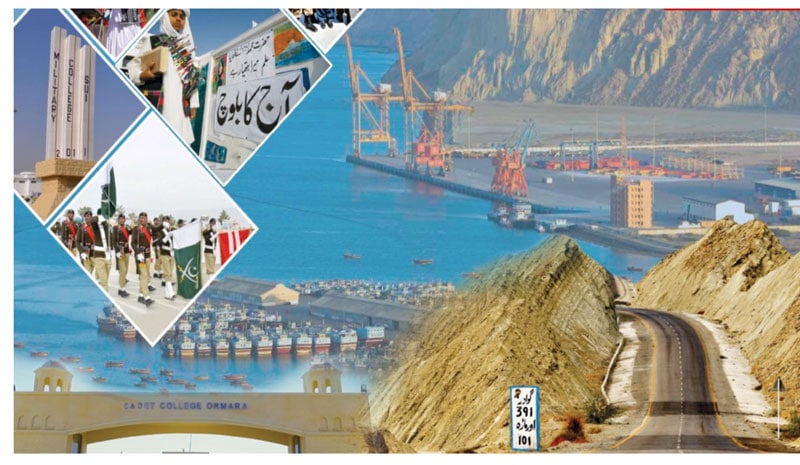THE inauguration of the Gwadar Port by the Chinese Prime Minister marked a pivotal moment in the revival of previously stalled projects in Balochistan. This construction work is set to address numerous grievances in a province that has long been underdeveloped and overlooked. Despite its wealth of mineral resources, Balochistan has historically made minimal contribution to Pakistan’s economy. This underutilization of its economic potential has stunted the province’s growth, exacerbated by geographical challenges and a predominantly impoverished demographic.
Reports indicate that property prices have surged in areas where infrastructure has been developed as part of the western route of CPEC. Cities like Kalat, Quetta and Zhob are anticipated to become more vibrant as planned road networks are completed, paving the way for economic activities and further development projects under CPEC.
CPEC is generating employment opportunities for the local population in sectors such as construction and transportation. The numerous infrastructure projects—including roads, ports and power plants—are creating jobs for skilled workers, ultimately benefiting the local populace. The significant improvement in Balochistan’s infrastructure is becoming increasingly evident. Once isolated, the province now enjoys newly constructed roads, highways and railways that enhance trade, mobility and access to essential services. With a sprawling network of 3,000 kilometres, CPEC is set to ease movement and facilitate economic development in surrounding areas.
The Gwadar Port is poised to become a vital commercial hub, equipped with state-of-the-art facilities capable of handling large cargo ships. This development is crucial for international trade and is expected to stimulate increased shipping and tourism activities around the port.
Beyond infrastructure, the broader socio-economic impacts of CPEC projects cannot be overstated. The development surrounding Gwadar Port promises to enhance local amenities such as schools, hospitals and recreational facilities for residents. Furthermore, the anticipated increase in trade and transit activities is likely to create new job opportunities for the local community, enabling comprehensive development.
The transformation of Gwadar from a small fishing town into a significant economic centre highlights the transformative potential of CPEC. This development is expected to bolster local industries, increase employment, and contribute to the economic growth of the region.
One of the key areas where CPEC is making strides is in addressing Balochistan’s energy deficits. Historically reliant on its natural resources, particularly minerals and gas, the province now has the opportunity to diversify its economy. The establishment of special economic zones linked to CPEC could lead to a boom in manufacturing, services, and logistics sectors, presenting new avenues for growth.
Moreover, several CPEC initiatives focus on technology and innovation, allowing Balochistan to benefit from an influx of new technologies. The establishment of smart cities, technology parks and innovation centres has the potential to reshape the province’s landscape, exposing its youth to global technological trends and opportunities.
Balochistan is not only known for its rich resources but also for its captivating scenery, history and culture, all of which hold substantial potential for tourism. The improvement in infrastructure brought about by CPEC, particularly in road and rail connectivity, can unlock this potential, transforming the province into a sought-after destination for domestic and international tourists. This shift could significantly enhance the local economy and create additional employment opportunities in the tourism sector.
Despite being dubbed the “basket of fruits,” it is ironic that Balochistan currently does not contribute to the export of dates, one of its primary agricultural products. Encouraging the export of dates and other fruits could address water scarcity issues while boosting production. With the support of CPEC, local farmers could find new markets for their crops, significantly impacting the province’s economy.
Agriculture serves as the backbone of Balochistan’s economy, with approximately 75% of its population relying on it for their livelihoods. The economies of districts such as Jaffarabad, Nasirabad, Osta Muhammad and Dera Murad Jamali are predominantly agricultural. Additionally, Balochistan’s livestock sector, which provides 52% of the country’s sheep, 41% of camels and 22% of goats, plays a critical role in the local economy, employing about 66% of households in drought-prone areas.
The concept of a blue economy—utilizing marine resources for economic benefit—holds great promise for Balochistan. With global marine economic activities estimated at approximately $1.5 trillion in 2010 and projected to reach $3 trillion by 2030, this sector is expected to generate significant economic activities and job opportunities.
The governments of China and Pakistan are committed to improving education and healthcare for the local population, with investment in socio-economic development projects. Professional training centres have been established in Balochistan to enhance the workforce’s skill sets, further contributing to the region’s development.
The initiation of the second phase of CPEC presents a significant opportunity for the local population of Balochistan. By fostering economic development, creating job opportunities and enhancing infrastructure, CPEC can help alleviate the province’s long-standing challenges. However, it is crucial that these development initiatives are inclusive, ensuring that they benefit local communities.









